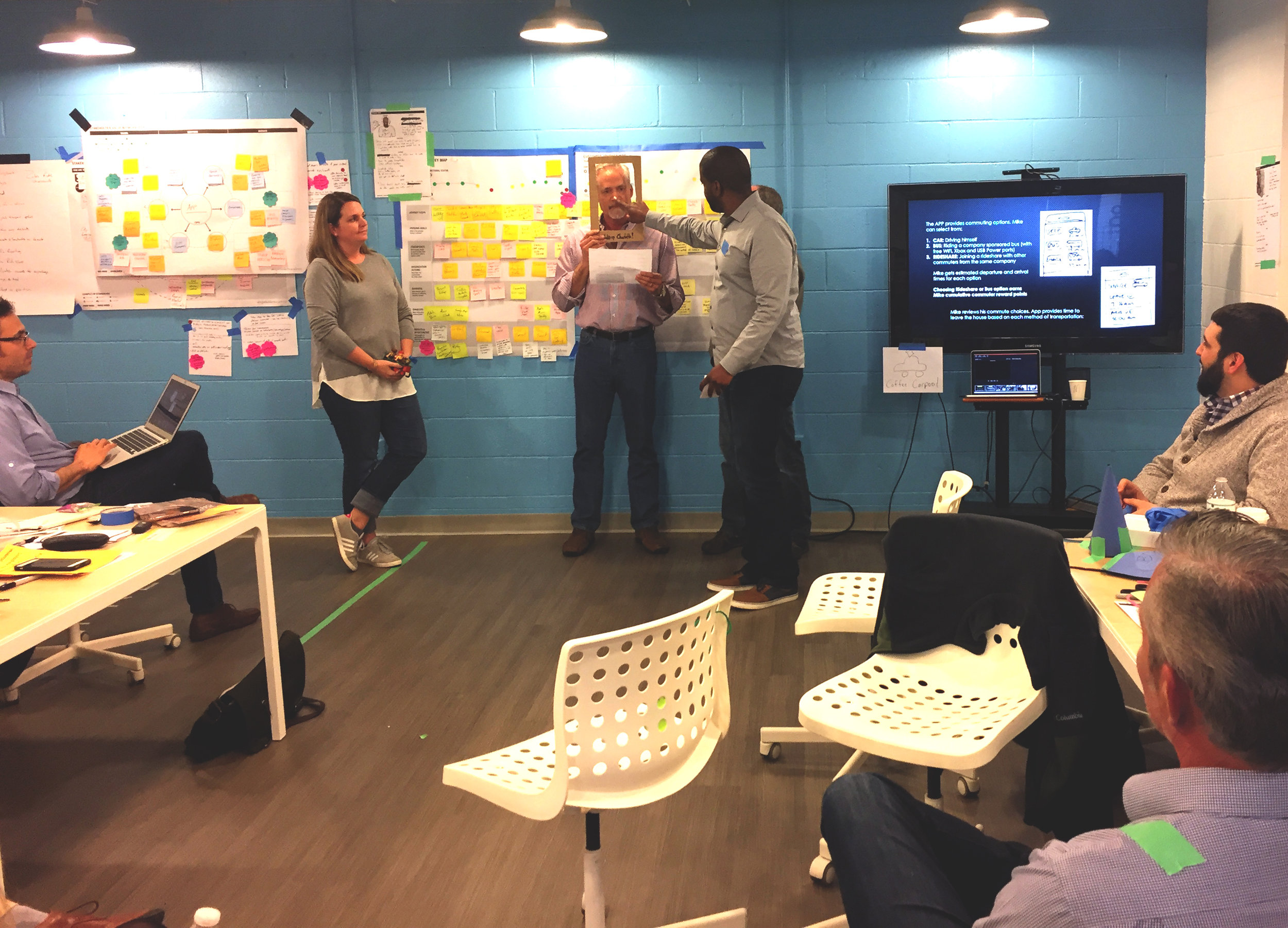Get valuable feedback to avoid idea infatuation
A team acts out their idea (complete with human animation) during a 2 day service design fundamentals training.
At Wily, we use rapid prototypes—hastily assembled ideas made tangible—to do 4 things for Fortune 100 and 500 companies, federal and city governments, and prominent nonprofits and institutions:
Find out if people want a product or service.
Make key decisions about form and function without overthinking it.
Get feedback so I can improve a product or service.
Gain shared understanding among project teams.
We'll dig into all 4 of these benefits in future posts. But for now, I want to focus on #3—getting feedback—and why it saves you time and heartache.
Get feedback before you’re ready
Making ideas tangible prevents you from spending valuable time trying to get your new idea “perfect.” Your early idea will never be perfect. But it can be better after giving it physical form and getting customer feedback. If the thought of putting your half-baked idea into the world makes you wince, you’re doing it right.
If you’re confident your new idea will blow your customers’ minds right from the start, you’ve waited too late to get feedback, and you should ask yourself if you’ve fallen in love with your idea (more on that later). Think of rapid prototyping as creating a crummy first draft. The sooner you embrace your prototypes as crummy first drafts, the sooner you'll be rewarded with better second and third drafts.
"Don’t wait for things to be perfect before you share them with others. Show early and show often. It’ll be pretty when we get there, but it won’t be pretty along the way."
— Ed Catmull, Pixar
Business as usual is soul-crushing
Making your ideas tangible is much more effective than alternative, traditional paths to idea development. We take these other paths far too often. A supervisor gathers the team, frames the challenge, and asks the team to create an idea or solution through unstructured brainstorming.
Then some brave soul offers a seedling of an idea, which quickly gets smashed with statements like “HR will never go for that” or “legal would have a field day.” Before long, any hint of new thinking gets snuffed out, and the whole endeavor devolves into a pitching and debating match with the loudest voice winning out.
I've been there, and so have you. It’s soul-crushing. Most people are well-intentioned creatures, but without carefully constructed “rules” that foster—rather than smash—creative expression, you find yourself in an unstructured mess that leads to incremental, mediocre ideas. These ideas do little to stir hearts, let alone make a meaningful dent in your challenges.
As explained by HBR, human brains are terrible at creating and evaluating ideas at the same time. Left to their own devices and traditional thinking, this is precisely what people do. Fortunately, you can use Design Sprints to help structure your thinking into creative (divergent) and critical (convergent) buckets. Design Sprints allow you to leverage each of these forms of thinking when they are needed most—a topic I'll dive into more in future posts about Design Sprints at Wily.
I taught a class of professionals at Wake Forest University's design thinking certificate program to build rapid prototypes. In this example, teams worked together to improve the middle passenger experience on commercial flights.
A rapid prototype created by a team of education professionals I trained. They were tasked with exploring educational program ideas at a human-centered design workshop. By making their ideas tangible, they arrived at a shared understanding and got meaningful feedback from other teams of education professionals.
Resist infatuation
When I say rapid, I mean rapid: I help project teams churn out early prototypes in as little as a couple of hours. Why the haste? It’s simple—we’re human, and being human means the more time you spend on an idea, the more you fall in love with it.
And what happens when you fall in love with your early ideas (*cough* or people *cough*)? You tune out everything that tells you your love interest isn’t perfect. Instead of considering opposing views that might improve your idea or convince you to leave a bad idea behind, you defend your beloved and untested idea to the death. And “death” often comes in the form of enormous wasted effort. Time, money, and talent get squandered when you cling to a flawed idea.
As a human, you are susceptible to the effect of confirmation bias, where you filter out everything except the information that supports your point of view. Worse, you’re vulnerable to blind spots, and view yourself as less susceptible to bias than others. I help teams avoid this pitfall all the time, but I too fall in love with my ideas and discard valuable feedback that might rain on my idea parade.
I’ve seen it happen with project teams even when a challenge has been chosen at random for the purpose of training. After just a couple of hours of digging into a challenge and developing even the earliest ideas, people grow passionate about their creations and some fall victim to defending their “preeeecious.”
There’s another way
So what can you do to avoid a bad love affair with your own ideas? Yep, you guessed it: use rapid prototyping. Why go fast? Because less time + feedback = less heartache. Remember, the more you work on an idea, the more you fall in love with it, and the less likely you are to accept or act on feedback.
But the inverse is also true: the less time you spend on an idea, the less likely you are to reject valuable feedback. Rough and raw ideas remind you and your audience that this is a work in progress, or that your idea “cake” is still being baked.
The unfinished nature of a rapidly constructed prototype helps you better accept criticism. It also encourages your audience to provide more candid feedback. They realize you’re still early in your development, and aren’t as worried about hurting your feelings.
What do hurt feelings have to do with anything? A lot. Humans are socially savvy creatures. You detect nuance in body language, tone, gestures, and other verbal and non-verbal cues. And you can sniff out a love affair in an instant.
What happens when you sense someone is in love with their idea? For a small number, it won’t matter: you'll simply tell it like it is. For many, though, your response is much different. After sensing your feedback might hurt someone, you dance around your true feelings, or hide them altogether.
Like most humans, you do this because you’ve learned that hurting someone’s feelings can have negative social consequences. So you avoid these consequences by remaining tight-lipped about your true feelings. In doing so, you withhold your feedback—feedback that could save a project team serious time, money, and effort.
If you just spent months of time and millions of dollars developing an idea, and a colleague or customer says “meh, I’d do it different,” you’re likely to freak out in defense of your idea. Conversely, if you spent two hours and a few bucks, “meh” isn’t as big of a deal. In this context, it might lead you to ask a customer what they’d change, and why. And maybe it leads you to follow that with a question about what parts of the idea they do like, and why.
When you’re open to feedback, a negative or lukewarm response gives you a chance to dig in and ask why. If a pattern of feedback suggests your idea is crummy, toss it out and start building your next idea. If there are some rough spots but the idea has merit, build on the good bits and revise or remove the bad. And do it fast.
“Make feedback normal. Not a performance review.”
— Ed Batista
Key takeaway
Make your ideas tangible as fast as possible, and date your ideas before you marry them. Because the less time you spend on your early idea, the less likely you will be to fall in love with it prematurely, and the more receptive to feedback you will be. Less time + feedback = less heartache.
Want to see a Design Sprint in action? Check out our upcoming Design Sprint Bootcamp with Jake Knapp, the creator of Design Sprints and author of Sprint. Learn more about our Bootcamp at wearewily.com.
Eric Gorman is owner and designer at Wily, an agency that uses Design Sprints to help people unlock their genius. Learn about Design Sprints at wearewily.com/design-sprints.




